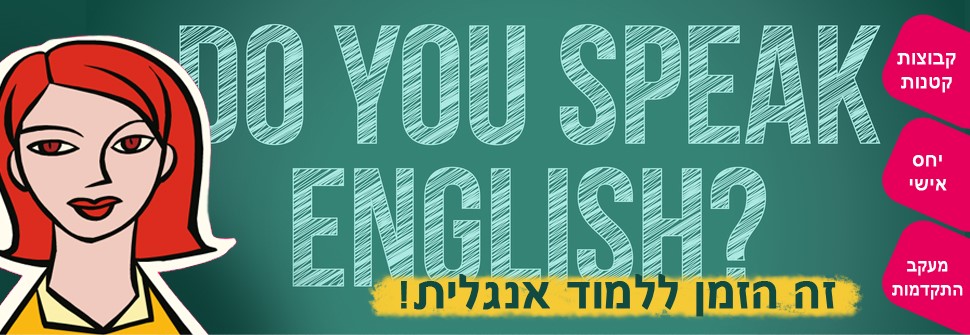


כיתות א - ה
לימודי אנגלית לכיתות א-ה
מטרתנו היא לשפר ולעודד תלמידים לעבר תקשורת טובה יותר, אוצר מילים נרחב יותר ודיבור וקריאה טובים יותר באנגלית דרך שימוש טבעי בשפה. שאיפותינו מכוונות לשימוש שוטף ופיתוח יכולות טבעיות ואינן נוצרו על מנת להחליף או להתנגש עם אנגלית הנלמדת במערכת החינוך בישראל. לכן, שיעורים אלו אינם מיועדים להכנה למבחני בית ספר, עזרה בשיעורי בית וכיו” – שיעורי תגבור ישמשו לשם כך לפי דרישה. לימוד המבנה הלשוני של השפה יירכש תוך כדי שימוש שגרתי בשפה עם דגשים נוספים לפי הצורך.
מטרה נוספת שלנו היא לתת לכל תלמיד תשומת לב אישית על מנת לוודא שמירב הפוטנציאל שלהם ימוצה בדרך היעילה ביותר. שינויים מתבקשים במבנה השיעורים יבחנו על פי צרכים אלו מעת לעת.
במהלך השיעור הראשון תלמידים יבחנו לקביעת רמת השליטה שלהם בשפה. זו בנוסף ליכולתם וצרכיהם ישמשו לשיוכם לקבוצה מתאימה ולאו דווקא גילם או שכבתם בבית ספר. לעיתים תלמיד יצטרף לקבוצה בה תלמידים מעט בוגרים או מעט צעירים מהתלמיד אם המורה תקבע שזו הקבוצה המתאימה ביותר לתלמיד.
מטרתנו היא לשפר ולעודד תלמידים לעבר תקשורת טובה יותר, אוצר מילים נרחב יותר ודיבור וקריאה טובים יותר באנגלית דרך שימוש טבעי בשפה. שאיפותינו מכוונות לשימוש שוטף ופיתוח יכולות טבעיות ואינן נוצרו על מנת להחליף או להתנגש עם אנגלית הנלמדת במערכת החינוך בישראל. לכן, שיעורים אלו אינם מיועדים להכנה למבחני בית ספר, עזרה בשיעורי בית וכיו” – שיעורי תגבור ישמשו לשם כך לפי דרישה. לימוד המבנה הלשוני של השפה יירכש תוך כדי שימוש שגרתי בשפה עם דגשים נוספים לפי הצורך.
מטרה נוספת שלנו היא לתת לכל תלמיד תשומת לב אישית על מנת לוודא שמירב הפוטנציאל שלהם ימוצה בדרך היעילה ביותר. שינויים מתבקשים במבנה השיעורים יבחנו על פי צרכים אלו מעת לעת.
במהלך השיעור הראשון תלמידים יבחנו לקביעת רמת השליטה שלהם בשפה. זו בנוסף ליכולתם וצרכיהם ישמשו לשיוכם לקבוצה מתאימה ולאו דווקא גילם או שכבתם בבית ספר. לעיתים תלמיד יצטרף לקבוצה בה תלמידים מעט בוגרים או מעט צעירים מהתלמיד אם המורה תקבע שזו הקבוצה המתאימה ביותר לתלמיד.
English Time’s teachers are experienced, skilled and knowledgeable. We care about
providing your child with the best educational start, aiming to strengthen their English
skills and give them a lifelong affinity for learning. We want the best for your child,
and customise our courses according to their needs, abilities and strengths.
Every child is interviewed and assessed prior to or during their first lessons, either
overtly or covertly, by asking simple questions to discover their current level of
knowledge, likes and dislikes, and reasons for learning English. They are then placed
in the class fitting their needs and ability. In today’s modern world, every child has
been exposed to some English – via television, radio and the internet, music, shop
signs and their general environment. All children understand what a smartphone, i-
pad or computer is – these are all English words.
Building lessons around activities that children enjoy has been proven to motivate,
heighten the learning experience and build a solid foundation for learning. For
example, if a child likes to draw or dance, incorporating those interests makes lessons
more enjoyable, fun and productive for that child.
Younger children are the most pliable and receptive learners. English Time
encourages parents to take advantage of that fact and provide their children with the
strongest possible base by learning English during their formative years. Lessons are
conducted in English as much as possible. Initially, children may find that strange
but quickly become used to basic English: ‘How are you?’ ‘What did you do last
week?’ ‘What’s your name?’ ‘Are you here?’ etc.
English Time uses the phonic (phonetic) method to teach the alphabet, in non-
alphabetical order according to which letters are most used and relating to their
sound (i.e., ‘C’ = ‘cat’), along with vocabulary associated with that sound. The
names of the letters become almost redundant after the age of five. After learning
the sounds – for older children, sometimes in conjunction with reading – we teach
the child to read correctly. Better letter sounds result in better reading which leads to
better understanding, making language learning more enjoyable. For more details of
phonics, see
http://www.edu.aurovilleportal.org/pedagogy/item/93-phonics-method-for-reading-
and-its-essential-aspects.
Although English Time believes that word lists or songs unrelated to real English
usage are not effective in the long term, our teachers do use them to reinforce
particular material, but not as the main focus.
providing your child with the best educational start, aiming to strengthen their English
skills and give them a lifelong affinity for learning. We want the best for your child,
and customise our courses according to their needs, abilities and strengths.
Every child is interviewed and assessed prior to or during their first lessons, either
overtly or covertly, by asking simple questions to discover their current level of
knowledge, likes and dislikes, and reasons for learning English. They are then placed
in the class fitting their needs and ability. In today’s modern world, every child has
been exposed to some English – via television, radio and the internet, music, shop
signs and their general environment. All children understand what a smartphone, i-
pad or computer is – these are all English words.
Building lessons around activities that children enjoy has been proven to motivate,
heighten the learning experience and build a solid foundation for learning. For
example, if a child likes to draw or dance, incorporating those interests makes lessons
more enjoyable, fun and productive for that child.
Younger children are the most pliable and receptive learners. English Time
encourages parents to take advantage of that fact and provide their children with the
strongest possible base by learning English during their formative years. Lessons are
conducted in English as much as possible. Initially, children may find that strange
but quickly become used to basic English: ‘How are you?’ ‘What did you do last
week?’ ‘What’s your name?’ ‘Are you here?’ etc.
English Time uses the phonic (phonetic) method to teach the alphabet, in non-
alphabetical order according to which letters are most used and relating to their
sound (i.e., ‘C’ = ‘cat’), along with vocabulary associated with that sound. The
names of the letters become almost redundant after the age of five. After learning
the sounds – for older children, sometimes in conjunction with reading – we teach
the child to read correctly. Better letter sounds result in better reading which leads to
better understanding, making language learning more enjoyable. For more details of
phonics, see
http://www.edu.aurovilleportal.org/pedagogy/item/93-phonics-method-for-reading-
and-its-essential-aspects.
Although English Time believes that word lists or songs unrelated to real English
usage are not effective in the long term, our teachers do use them to reinforce
particular material, but not as the main focus.







